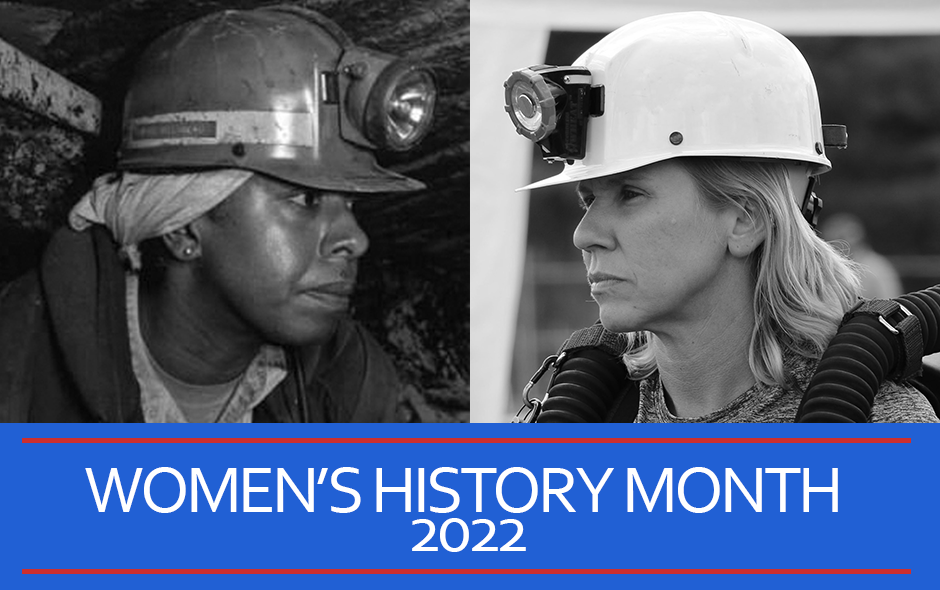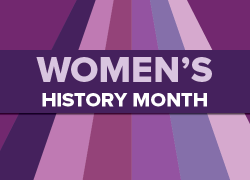
Throughout America’s history, women have played a critical role in mines and mining operations, often in the face of prejudice and other hardships due to their sex. During Women’s History Month, we recognize the contributions women have made in the mining industry and their role in creating opportunities and better working conditions in mines.
Here are a few milestones from the history of women in mining:
1860s:
- In the nineteenth century, women worked in mining as prospectors, ore processors, miners, managers and mine owners. Women “grubstakers” sometimes financed the initial cost of prospecting in return for part-interest in any claim. In 1863, Mrs. Robert K. Reid discovered a vein of silver ore and filed a claim in her own name in Bingham Canyon, Utah, the site of one of our nation’s largest mines.
1890s:
- In the 1890s, two schoolteachers from Seattle, Washington, Annie A. Coffin and Stella L. Goodspeed, discovered a rich mining property in the Goat Lake area of the Cascade Range. Coffin and Goodspeed rode the train from Seattle to Hartford and then, carrying packs of equipment and armed with revolvers and extra ammunition, walked 35 miles into the mountains, and climbed 3,000 feet up Mt. Monte Cristo. Their finds were heralded by the Seattle Times on July 7, 1896, in headlines that read, “Gold was willing. Two Seattle teachers discover rich mines.”
1960s:
- Though no federal law prohibited women from working in the mining industry, tradition, cultural restraints and employer resistance all limited women’s opportunities for employment in mining. This began to change in the 1960s.
- On September 24, 1965, President Lyndon B. Johnson signed executive order 11246, stating that coal companies with federal contracts could not discriminate in employment because of a person’s race or sex. The law was on the books, but women still faced discrimination in the industry. President Richard Nixon signed the Equal Employment Opportunity Act of 1972, which expanded and strengthened the scope of equal employment. This law allowed women to become more forceful with discrimination charges against coal companies.
1970s:
- In 1974, Diana Baldwin, a former hospital receptionist, and Anita Cherry, a former practical nurse, became the first women to work in a coal mine. They were also the first female members of the United Mine Workers of America to work inside a mine.
- By the mid-1970s, the largest American coal companies with federal contracts began hiring female miners with more regularity. A major administrative complaint, filed with the U.S. Department of Labor in 1978 against 153 of the nation’s largest coal companies and mines, expanded job opportunities for women in the industry.
- Many of these newly hired women worked in underground mines in the Appalachian coalfields. Between 1974 and 1980, almost 2,400 women were hired as underground coal workers in the Eastern U.S., while only 242 were hired in the Midwest, and 272 in the West. Underground coal mines required a larger workforce than other types of mines.
- In 1977 two public interest groups requested a tour of an underground mine in Campbell County, Tennessee. Because a woman was in one of the tour groups, mine officials refused their request. This discrimination kicked off the most thorough investigation of sex discrimination in coal mining history, known as the Coal Employment Project. CEP became an active committee for the protection of women against discrimination and sexual harassment. It also helped many women make the transition into an industry long dominated by men.
- In November 1978, the United Mine Workers of America unanimously passed a resolution to support increasing options for women in mining. Women became active members of the UMWA, and several women were elected as delegates to the UMWA’s 1978 convention, where union policies and contract demands were formulated. This was the last “boom” year of the decade, with nearly 18,000 miners hired nationwide. For the years 1978-1980, women made up 6.5 percent of all new underground workers.
- Mining is a dangerous occupation, and miners face a variety of environmental and industrial hazards. In 1979, there were 144 mining fatalities. One of these was Marilyn McCusker, a roof-bolter helper and the first woman coal miner to die on the job. McCusker, died from a roof fall in a coal mine in Pennsylvania. It had taken her two years and having to file a sex discrimination suit in federal court to get her job. In McCusker’s case an investigation found the operator failed to support a damaged roof area adequately, which caused the accident.
- Her husband, Allen, was denied widower’s benefits. Pennsylvania compensation law stated that a widow automatically receives benefits, but that a widower must prove that he is incapable of earning his own living. Two days before the hearing before the Workmen’s Compensation Board, the coal company agreed to pay widower’s benefits to Allen McCusker.
1980s:
- In 1981 the Coal Employment Project conducted a survey to learn about sexual harassment in coal mines, and found widespread and serious concerns related to both harassment and discrimination in the industry: 17 percent of respondents said they had been physically attacked on the job, 36 percent felt they were given harder, more dangerous, or less rewarding jobs than their male co-workers, and 66 percent of the women reported being propositioned by a co-worker.
- As more opportunities became available, the number of women coal miners increased from zero in 1973 to 33,730 in 1983 when women made up 8.6 percent of the mining workforce.
- In 1983, at the 5th National Conference of Women Miners, workshops were aimed specifically at problems women miners encountered on the job. Concerns addressed at this conference were the type of protective clothing they were required to wear and the waiting period of 90 days from the time they were hired before being allowed to operate mining machinery, while the same waiting period did not equally apply to their male counterparts. Conference participants were also concerned over pregnant miners who were given job assignments that were more taxing than their physical condition would allow.
Today, women hold every type of job available in the mining industry, from general laborer to mining engineer in underground and surface mines, and coal metal and nonmetal mines. And here at MSHA we look forward to continuing our efforts to raise awareness of the critical role women play in the mining industry.
Holly Armstrong is the supervisor program information specialist for the Mine Safety and Health Administration.

 U.S. Department of Labor Blog
U.S. Department of Labor Blog

